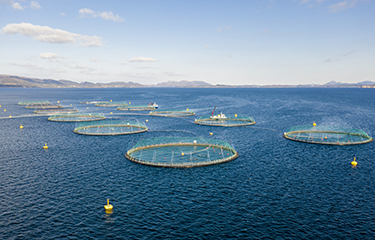Lerøy Seafood Group (LSG) achieved increased revenues of NOK 5.3 billion (USD 520.5 million, EUR 481.5 million) in the first quarter of this year, up from NOK 4.7 billion (USD 461.6 million, EUR 426.9 million) in the corresponding period of last year. At the same time, its operating profit before fair value adjustments climbed NOK 125 million (USD 12.3 million, EUR 11.4 million) year-on-year to NOK 816 million (USD 80.1 million, EUR 74.1 million).
Lerøy CEO Henning Beltestad explained that Q1 earnings for the farming and wild catch segments improved, but those of its VAP, sales, and distribution (VAPS&D) segment declined. He also said the effects of the COVID-19 crisis increased as the company progressed through the opening months of the year.
“The COVID-19 pandemic started to have an impact on operations in the first quarter, worsening throughout the first quarter and into the second quarter,” Beltestad said. “I am very proud of the group's employees, who have found constructive solutions and displayed a wonderful determination, working extremely hard to keep the group's value chain open and ensure deliveries to our customers.”
LSG’s Q1 2020 profit before tax and fair value adjustment related to biological assets was NOK 734 million (USD 72.1 million, EUR 66.7 million), compared with NOK 748 million (USD 73.5 million, EUR 68 million) a year previously. Meanwhile, its associated operations reported a loss of NOK 17 million (USD 1.7 million, EUR 1.5 million), compared with a profit of NOK 73 million (USD 7.2 million, EUR 6.6 million) in Q1 2019.
The farming segment reported operating profit before fair value adjustment related to biological assets of NOK 562 million (USD 55.2 million, EUR 51.1 million) in Q1 2020, compared with NOK 510 million (USD 50.1 million, EUR 46.4 million) a year previously.
Its Q1 slaughter volumes of salmon and trout increased by 22 percent year-on-year to 39,377 gutted-weight tonnage, while the earnings before interest and taxes (EBIT) fell from NOK 15.80 (USD 1.55, EUR 1.44) per kilogram in Q1 2019 to NOK 14.30 (USD 1.41, EUR 1.30).
“At the start of the first-quarter, the spot prices for salmon were high. These fell during the quarter, partly due to the impact on demand relating to the restrictions laid down to control the COVID-19 pandemic. What's more, prices realized were negatively affected by an abnormal high share of winter ulcers on fish,” Beltestad said. “The group reported higher release from stock costs in Q1 2020 when compared with the same period last year, but expects to see a fall in these costs in the second-half of 2020.”
Within LSG’s Wild Catch segment, Havfisk's total catch volume in the last quarter was 25,009 metric tons (MT), compared with 20,536 MT in Q1 2019. The main catch species were cod (12,530 MT), haddock (5,198 MT), and saithe (3,602 MT). Compared with Q1 2019, the average price for cod increased by 13 percent, haddock was 12 percent higher, and saithe was up 33 percent.
Along with its LNWS whitefish processing operations, which encountered higher raw material prices due to increased demand and lower quotas, the segment reported an EBIT of NOK 270 million (USD 26.5 million, EUR 24.5 million) for the opening three months, compared with NOK 171 million (USD 16.8 million, EUR 15.6 million) in the same period of 2019.
Beltestad highlighted that good catch efficiency, increased volume, and higher prices resulted in good earnings for the trawler fleet in the opening quarter, while new trawler “Kongsfjord,” delivered in February, was already proving a sound investment.
“The high prices for raw materials in the quarter remain a challenge for earnings from onshore operations, but we have witnessed how the investments we have made in recent years have generated significant improvements in the group's product range and position on global seafood markets,” he said.
In the last quarter, the VAPS&D segment achieved increased revenues of NOK 4.9 billion (USD 481.6 million, EUR 445.6 million), however increased costs and risk had a negative impact, said LSG. As such, operating profit before fair value adjustment related to biological assets fell by NOK 25 million (USD 2.5 million, EUR 2.3 million) to NOK 54 million (USD 5.3 million, EUR 4.9 million).
“COVID-19 has affected trends for demand, with an increase in consumption volumes within retail but with practical closure of the HoReCa (Hotel, Restaurant and Cafe) markets in many central areas. The pandemic has also had an impact on logistics, particularly for overseas markets, with a reduction in cargo capacity resulting in increased costs during the period. The main focus for the VAPS&D segment has been to keep the value chain open. Activities in Q1 2020 have been good, with revenue up 9 percent on Q1 2019.” Beltestad said.
For the full-year 2020, LSG estimates a 2020 total salmonid harvest between 183,000 and 188,000 gutted weight tonnage, including its volume from associates, and also a whitefish catch of approximately 65,000 MT.
Photo courtesy of Lerøy Seafood Group







